
1458
.pdf
МИНИСТЕРСТВО ОБРАЗОВАНИЯ И НАУКИ РОССИЙСКОЙ ФЕДЕРАЦИИ
Федеральное государственное бюджетное образовательное учреждение высшего профессионального образования "Пензенский государственный университет
архитектуры и строительства" (ПГУАС)
АНГЛИЙСКИЙ ЯЗЫК ДЛЯ БУДУЩИХ АРХИТЕКТОРОВ И СТРОИТЕЛЕЙ
Рекомендовано Редсоветом университета в качестве учебного пособия для студентов, обучающихся по направлениям подготовки
08.03.01, 08.04.01 «Строительство», 07.03.01, 07.04.01 «Архитектура»
Пенза 2014
УДК 811 ББК 81.2англ.
А64
Рецензенты: кандидат филологических наук, доцент С.В. Бобылева (ПГТУ); кандидат филологических наук, доцент Е.Г. Стешина (ПГУАС)
Авторы: Сботова С.В., Милотаева О.С., Горбунова В.С., Козина Т.А.,
Английский язык для будущих архитекторов и строителей: А64 учеб. пособие / С.В. Сботова [и др.]. – Пенза: ПГУАС, 2014. –
172 с.
Содержит материал по темам, изучаемым в строительном ВУЗе, а также тексты, рассказывающие о новых строительных материалах. В учебном пособие представлены упражнения, позволяющие понимать тексты и задания к ним. Пособие хорошо иллюстрировано.
Подготовлено на кафедре иностранных языков и предназначено для студентов, обучающихся по направлениям подготовки 08.03.01, 08.04.01 «Строительство», 07.03.01, 07.04.01 «Архитектура».
©Пензенский государственный университет архитектуры и строительства, 2014
©Сботова С.В., Милотаева О.С.,
Горбунова В.С.,Козина Т.А., 2014
2
ПРЕДИСЛОВИЕ
Учебное пособие содержит материал по темам: Строительные материалы, Камни и их классификация, Виды цемента, Бетон, Искусственный камень, Древесина, Стекло, Краски и многие другие.
Пособие состоит из трех частей и нескольких разделов, в которых представлены тематические материалы по строительству на современном английском языке. В пособии также представлены задания, на основе выполнения которых проверяются знания изучаемого материала и практикуется его использование в речи на английском языке.
Тексты сопровождаются англо-русским вокабуляром, облегчающим понимание текста и иллюстрациями. Каждый текст заканчивается контрольными вопросами для проверки понимания текста.
Трудности понимания предлагаемого материала снимаются благодаря использованию авторами тематических глоссариев, представленных на английском и русском языках.
Материал, представленный в данном учебном пособии, является базовым и необходимым для формирования навыков понимания текстов на английском языке. Пособие поможет студентам научиться читать и понимать аутентичные тексты, выполнять их адекватный перевод, вести беседы по изучаемой теме.
Пособие подготовлено на кафедре иностранных языков и предназначено для бакалавров, магистрантов и аспирантов, изучающих английский язык в неязыковом вузе.
Учебное пособие может быть использовано студентами и обучающимся по всем специальностям неязыкового вуза.
3
PART I. TEXTS FOR COMPREHENSIVE STUDY
BUILDING MATERIALS - THEIR NATURE, PROPERTIES AND
MANUFACTURE
Text 1. Stones: practical classification and general distinctions
1. Read the following words and word combinations. Find the sentences with these words and word combinations in the text and translate them into Russian.
magnesia – магнезия, окись магния to quarry – добывать
feldspar – полевой шпат hornblendе – амфибол mica – слюда
potash – поташ
to solidify – твердеть, застывать manganese – марганец
tough – жесткий, упругий
igneous rocks – горные породы вулканического происхождения argillaceous – глинистый
shale – сланец
conveyed to the sea – переправленный в море lateral – горизонтальный, боковой, поперечный cleavage – расщепление, раскалывание
thaw – оттепель; топить, растопить; таять, растаять, смягчаться lichen – лишайник
superficially – поверхностно lump sugar – кусковой сахар to derive – извлекать
vein – вена, жила
to retain – удерживать, сохранять to intermingle – смешивать(-ся)
to percolate – проникать, просачиваться mottled surface –пятнистая поверхность
serpentine – змеевидный,извилистый, извивающийся translucent – полупрозрачный, просвечивающийся onyx – оникс
stalagmitе – сталагмит
divergence – расхождение, отклонение sedimentary – осадочный
4
fossil – ископаемый, окаменелый to traverse –пересекать
vertical percolation – вертикальное проникновение fissure – трещина, расщелина
dolomite – доломит; the Dolomites - Доломитовые Альпы abundant – обильный
flint – кремень
shingle beaches – пляжи, покрытые галькой insoluble – нерастворимый, неразрешимый angularity – угловатость
rust – ржавчина
2. Read and translate the text.
The classification of stones as basalts, granite, slates, marbles, limestones, and sandstones. The term basalt is made to include all black, heavy or homogeneous. The true basalt is an Augitic stone, named after the mineral Augite or Pyroxene, of which, with Labradorite Felspar (a silicate of alumina and lime), it is composed. Augite having magnesia for its base, and being of a dark or black colour. There is much of it in the British Islands, but it is so difficult to quarry and hard to work that it is little used, save locally as road metal.
Granites comprise all stones of independent crystals of differing materials, which are so intimately connected as to form a homogeneous whole, and include most of the felspathic and hornblendic stones. All true granites contain felspar and quartz, and the ordinary typical granite consists of felspar, quartz, and mica, while many contain hornblende also. Of these constituents, the felspar is generally of that description known as Orthoclase, which is a silicate of alumina and potash, though the Labradorite felspar is also found. Felspar varies in colour, being sometimes white, sometimes grey, sometimes pink, and sometimes a deep rich red, and the colour of the granite, of which it forms a large part, varies accordingly.
The quartz crystals also vary in tint, though they are frequently white. They are almost pure oxide of silicon, otherwise known as silica; and it is found that they contain minute cells partly filled with water. The grains of felspar and mica are partly embedded in the quartz grains, and hence it is concluded that the quartz was the last to solidify. The mica occurs as small flakes of dark colour, which flash as they catch the light. It is a source of weakness, as it is liable to decay.
Hornblende, otherwise known as Amphibole, is a silicate of magnesia and lime, with iron and manganese. It is a very tough mineral, of a dark green or black colour, and frequently occurs in granites in small distinct crystals.
5
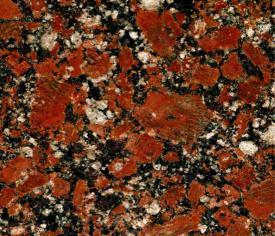
Granites which contain hornblende in place of or in addition to mica, are called Hornblendic or Syenitic granites, while other stones which contain felspar and hornblende alone, without either quartz or mica, are not granites at all, but Syenites, though in practice they are included among the granites. The crushing resistance of an ordinary granite varies from 5 to 12 tons per square inch, as tested on small cubes.
Under the term granite are commonly included other igneous rocks, little used for building purposes, such as the Porphyries, Elvan (of fine grain and free from mica), and Gneiss, which is constituted like granite, but has the mica more in layers, along which it splits easily, coming out in slabs from a few inches to a foot in thickness.
True slates are argillaceous in composition that is, they are composed of clay (silicate of alumina) and little else. The chemical elements of all clay, shales and slates are aluminium, silicon and oxygen, and the origin of all alike is to be found in the natural production of Kaolin, a pure white clay, by the decomposition of the felspar of felspathic rocks such as granites. This is washed into streams and rivers and so is conveyed to the sea, where, consisting of matter in an extremely fine state of division, it is carried further from the shore than the other ingredients of the original granite, and so is deposited separately, forming a clay bed. This forms material for newer clays, and so on; while clay beds which have long been subjected to vertical pressure have been compacted into shales and mudstones, and when these again are subjected to great lateral pressure and high temperatures they have been changed into the hard and strong material known as slate. Owing to the extremely high temperature at which the change takes place, slate, like all other metamorphic and igneous rocks, contains no organic remains. It is practically non-absorbent, and as it can be split into exceedingly thin parallel layers of considerable size, it is a most valuable roofing material. The crushing resistance of slate varies from 6 to as much as 14 tons per square inch, while its transverse strength is greater than that of any other stone.
Many other stones, both sandstones and limestones, which naturally occur in thin enough layers to be used for roofing purposes, are locally known as
6
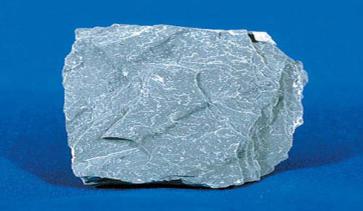
“slates”, or sometimes as “slate-stones”, or “tile-stones”. These, however, split along their planes of bedding, and not along planes of metamorphic cleavage, and so are not true slates, having, in fact, each the characteristics of the class of stone to which it belongs.
Coly weston “slates”, though used as roof coverings, are really limestone of a dark grey colour. The stone is obtained in the form of a block, or slate log, showing no sign of lamination. The logs are quarried in the summer and exposed to the weather through the winter, being watered daily except when hard frozen. If the winter be one of successive frosts and thaws, the block splits into thin slabs, while continuous frost with few alternations will produce thick slabs only, the splitting being done entirely by the weather, and the “slates” being ready for use when the spring arrives. All such, however, are more absorbent than true slates, and require strong roof timbers to carry them, while they foster lichen growth; but their colour is pleasing, and some architects use them to a considerable extent.
The term marble has come to include in practice not only marbles proper, but all limestones and even some other stones which are capable of being highly polished, and which then superficially look like marbles. True marbles are composed of practically pure carbonate of lime in a highly crystalline form, resembling lump sugar in structure. This resemblance is so strongly marked in the white that it has been given the name of “saccharine marble”. The white marble has been metamorphosed from pure white limestones, while the coloured marbles derive their colour from impurities, mostly oxide of iron, in the original limestones from which they have been changed, the colour having run into beautiful veins and markings during metamorphosis. Almost all colours are represented, and all combinations of colour. The crushing resistance of marble is about equal to that of granite, while its weight varies little from i/olbs. per cubic foot. Like granite and slate it is also an excellent weathering stone, and can be obtained in large blocks; though it does not, as a rule, retain its polish for any length of time if exposed to the weather. The combination in the same stone of strength, size of block and beauty of colour and texture, renders marble one of the most valuable of building materials. These are metamorphic igneous rocks,
7
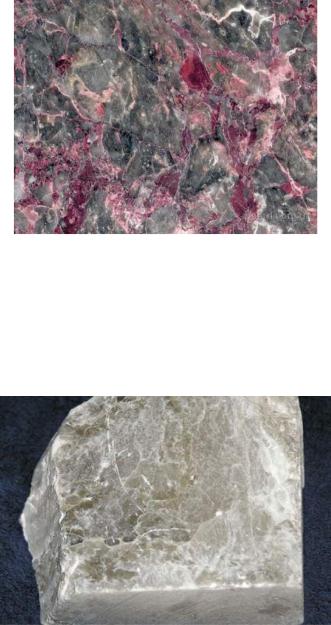
produced by the alteration under heat of igneous rocks rich in olivine, which contains some 84%, of silicate of magnesia. This is frequently found intermingled with carbonate of lime formed by water percolation, and the result is a stone having a beautiful mottled surface. Though heavy and capable of carrying heavy loads, it is soft and easy to work, but it weathers badly, and so cannot be used externally with success. Lithologically, serpentines are Paleose stones, the mineral talc, which consists of silicate of magnesia and occurs in other forms as French chalk, steatite and asbestos, being its basis.
Alabasters are also commonly and wrongly classed among the marbles. The true Oriental Alabaster is a beautiful translucent and nearly white limestone, often now erroneously called onyx marble, whose circular markings indicate its stalagmitic origin. It is difficult to obtain, and is replaced in general use by the softer sulphate of lime, also known as alabaster, the two being superficially similar. Alabaster should only be employed internally and for ornamental purposes.
The term limestone, which properly includes the true marbles, is in practice restricted in its use to such stones, composed mainly of carbonate of lime, as are of so open a texture as to prevent their taking a polish. Even so, a wide range is covered, and many sub-divisions are possible. In physical structure alone there are wide divergences, ranging through all grades from the loosely compacted
8
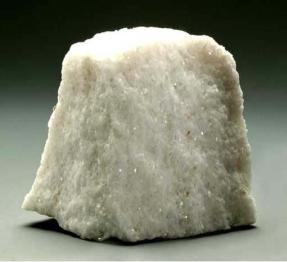
chalk, which consists of the shells of minute formaniferae, to the homogeneous Kentish Rag, the oolites occupying a middle position.
Oolitic stone as a rule is easy, and consequently inexpensive, to quarry and work, and is therefore known as a “freestone”, while it possesses uniformity of colour (generally a light cream or brown), comes to a good surface, and weathers satisfactorily. Of sedimentary origin, it lies in beds, often of considerable thickness, though the “bedding” is still visible in the blocks. Sometimes this is shown by the position of fossil shells, which always lie flat on the beds, and sometimes by markings which, if of clay, are sources of weakness. Other markings, however, frequently traverse the beds, and are due to the vertical percolation of water through fissures; and these are not to be mistaken for bedding marks. Frequently the effect has been for the water to convey carbonate of lime to a fissure, which from being a source of weakness has become a source of strength on being filled with a crystalline substance; and in other cases a similar result has been achieved by percolation of silica, though silica veinings of this sort render a stone comparatively hard to work. Lias Limestones which, practically speaking, do not necessarily occur only in the lias formations are such as include a considerable proportion of clay in their composition. They occur generally in thin beds only, and are more useful for street pavings than for building purposes, though they look well as “shoddies” rough ashlar facing blocks with freestone dressings, on account of the contrast of colour, the lias stones being generally of a dull and somewhat deep blue. The Dolomites or Magnesian Limestones are also exceedingly important impure limestones. While magnesian limestones vary greatly in composition, the true dolomite is of a peculiar granular and crystalline structure, and is known to mineralogists as Bitter-spar, consisting of 54 parts of carbonate of lime to 46 parts of carbonate of magnesia in indivisible crystals. As a rule a dolomite is fine of grain, and uniform in colour and texture, moderately easy to work, and an excellent weathering stone. Some of them contain a considerable proportion of
9
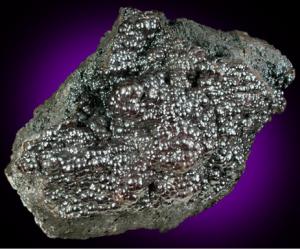
silica in the form of sand grains, and so are, perhaps more properly, classed among the sandstones by many writers.
The sandstones include all stones whose grains are composed of silica. This mineral, the most abundant in Nature, assumes various forms, in some of which it is known as rock crystal, flint, chalcedony, agate, and amethyst, and constitutes not only the sands of the sea shore and the desert and the pebbles of shingle beaches, but the framework of many tropical sponges. This silica, or quartz as it is also called, being practically insoluble and of great hardness, endures when associated minerals are dissolved, decomposed, or reduced to impalpable dust. Thus the sand of which sandstones are composed has been derived either from quartzose igneous rocks such as granite, from the quartz veins of the older sedimentary rocks, from flints and from the destruction of older sandstones and beds of sand. The grains consequently vary much both in size and angularity, some sandstones being composed of grains both larger and angular, while others have very small and rounded grains, worn down to their present condition by long-continued rubbing by the action of moving water; and all degrees between these two extremes are met with. Some tropical sandstones consist entirely of microscopical diatoms, or the siliceous framework of minute marine organisms, of marvellously beautiful forms. It is thus evident that the terms hard and soft, as applied to a sandstone, have no reference to the material of which the grains are composed, but only to the stone as a coherent mass, and so depend upon the character and amount of the cementing material. This varies also. It may, like the grains, be of silica, in which case the resulting stone is white and may be very hard; or it may be of peroxide of iron, familiarly known as rust, forming a thin red coating to the grains, and giving a red, brown or yellow colour to the stone, which may be very soft or very hard; or it may be of clay, or of carbonate of lime; or it may be a combination of two or more of these substances.
10
